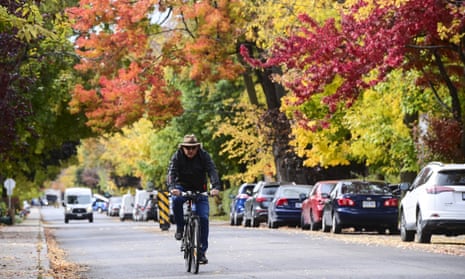At the outset of the Covid-19 pandemic, some workers found themselves at home, momentarily (at least they thought) liberated from the many impositions of office work – including commuting. Now, instead of waking up early, getting dressed and schlepping to the office and back, people had time to do anything they want. Which is why it might be surprising that some are still pretending to commute.
“When I [started] working from home, I had this gap in my day. At first I was like, ‘Wow, like I have a lot more time, I can sleep in!’ But there are a lot of aspects of the commute I just was missing,” says Kerri Jesson, a digital marketing associate in Vancouver, British Columbia.
Before the pandemic, Jesson had planned her day while on public transit – going over her to-do list, checking her calendar, and getting ready to transition into work mode. “I didn’t even really realize that I was prepping myself for the day until I no longer had the ability to do that,” she says.
In an effort to regain the satisfying elements of her former routine, Jesson began faux commuting several months ago. Now, she drives about 20 minutes to a coffee shop most mornings, before her workday starts. Not only does Jesson’s commute create a buffer between her work and personal time, but it “adds that more human aspect” back into her day.
“When you’re commuting, there’s hundreds of people around you, so it’s kind of like everyone’s in it together,” she says. Jesson is clearly not the only one craving this sort of downtime. Microsoft has tried to recreate the benefits lost from commuting by creating a “virtual commute”, giving employees time to set goals in the morning, and reflect back on the workday at its end – with an optional short guided meditation to round everything off.
John Dorsey, an attorney in Washington DC, had been cycling 40-odd minutes to work and back every day for 20 years when the pandemic hit. For him, cycling was a way to avoid heinous city traffic while exercising, or to listen to the occasional HG Wells audiobook.
Dorsey’s last day working in an office was a Friday, and the following Monday he was already back out there on his “circular commute”, a 15-mile morning ride through Rock Creek Park that’s become a favorite pastime. “It’s an hour where I don’t really need to talk to anybody, I’m just sort of away,” he says.
But with winter’s freezing temperatures, you would think some cyclists might appreciate a break from their morning commute. Apparently not, for cyclist Louis Philippe, a business analyst in Mississauga, Ontario, who has continued cycling to work through winter, but from the comfort of his own home.
Philippe appreciates the meditative qualities of a morning “fake commute” cycle – but swapped out the rush of wind in his hair and got his adrenaline pumping from November onwards using a stationary bike in his basement. “As soon as it starts getting dark early and we change the clocks I have trouble getting up to [bike outside] early in the morning,” he explains.
Studies support the fact that commutes offer the benefit of creating psychologically useful transition periods between work and home life. Consciously signaling to the brain and body it’s time to stop working is especially important when we’re working from home: a recent study of 3.1 million people by the National Bureau of Economic Research determined that following lockdown orders, remote workers stayed on the job almost 50 minutes longer every day than they did while in office, a trend which could exacerbate burnout.
Before the pandemic, when commuting was obligatory, its healthy, boundary-creating elements may have felt like a meager silver lining around a dark cloud of drudgery and stress to many.
Now, faux commuters can journey on their own terms, choosing where to go – like a park instead of gridlocked traffic; they can choose their mode of transportation – like a nice walk rather than a dark subway ride; and how long they want to “commute” for – perhaps just in the morning, afternoon, or both.
Jessica Eastman, a naturopathic doctor and a faux commuter herself, even believes a commute can be the secret to a high-quality sleep – something many have found harder to get during the pandemic. Now, Eastman prescribes morning and after-work walks to her clients to help them clear their minds and get better rest.
“People are having a really hard time falling asleep at the end of the day after working remotely,” she says, explaining how time blurs together without clear slots for things like lunch, start time and finish time.
Without the time to process and clear information, she says we end up finally doing it at the end of the day, when we lie down to sleep – keeping us up at night.
“Not only is [the faux commute] really vital for helping to regulate mood, energy and focus for the day, it’s also super vital for optimizing sleep quality and the capacity to fall asleep with ease in the evening.”
At the very least, faux commuting is as good a reason as any to get out of the house.
